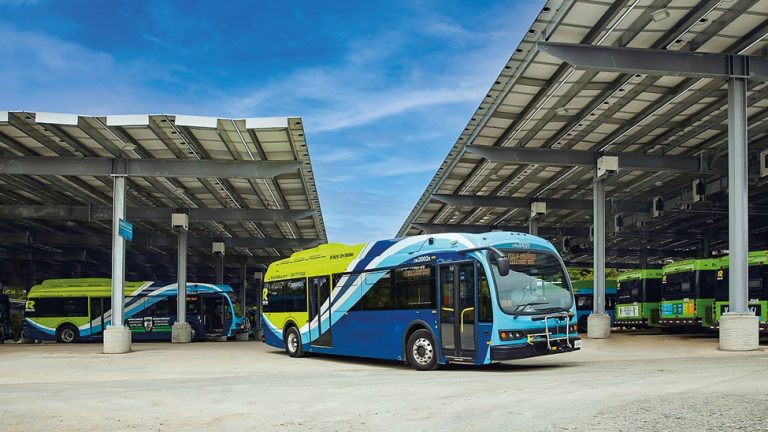Guest Contributor |
The looming energy and climate crises may seem like two separate events, but they are two sides of the same coin.
When we consider that energy-related greenhouse gas emissions make up 80 percent of all emissions from human activity, and that more than 60 percent of the total energy produced globally is lost or wasted before it is consumed, it becomes clear that decarbonization is actually energy. challenge.
Recently, my fellow experts at Schneider Electric and I participated in a documentary series with CNBC about how to reduce energy demand in three important areas: buildings, industry and transportation, and how addressing energy demand will contribute to more than half of the changes needed for complete decarbonization.
The future of buildings must be fully digital and fully electric
According to the World Green Building Council, buildings are responsible for nearly 40 percent of all energy-related carbon emissions worldwide. Nearly three-quarters of this energy comes from the energy that heats, cools and powers them, and digitalization and electrification are powerful ways to change this.
Building rehabilitation plays a big role in this. Installing low-energy design elements, such as better insulation, LED lights, and highly efficient air conditioning systems is just the beginning, but the real impact comes from digital energy management tools like sensors that monitor temperature, humidity, noise, and light levels. And software that can analyze and visualize energy use, enabling residents and building managers to make informed decisions in real time to improve comfort and efficiency.
It is necessary to increase the energy efficiency of new buildings as well. This includes efficient cooling and heating that impacts the future global climate, the integration of electric vehicle charging stations and the use of zero- or low-carbon materials.
A good example of this is CityCon in Finland. The developer creates buildings and cities with several sustainability strategies in mind. CityCon recently partnered with Schneider Electric to install a virtual power plant solution at the Lippulaiva shopping center in Helsinki, Finland. The virtual power plant harnesses solar energy, energy storage and demand flexibility while the software platform uses artificial intelligence to monitor and manage all building technology systems as well as control and optimize energy flows. This has since led to a significant reduction in carbon dioxide emissions.
Decarbonization opportunity in energy-intensive industries
The industry is responsible for around 30 per cent of all energy-related emissions, so it is important that the 2020s become the “electric decade”, where sites and entire supply chains are decarbonised.
Industries can take matters into their own hands using a microgrid, a self-sufficient power system that serves a nearby building or business. It combines on-site renewable energy production, battery storage and electric vehicle charging points so organizations can achieve energy flexibility, lower costs and reduce their carbon footprint.
For example, the microgrid built by Schneider Electric for a factory in Spain features 852 kilowatts of photovoltaic capacity, five electric vehicle charging points, and 80 kilowatt-hours of battery storage, all of which can be controlled through comprehensive software. At maximum output, the grid's PV power can power a small room's lighting for more than six and a half years, with the battery storing enough energy to power 80 laptops, all day, for 80 days straight.
Elsewhere, Molino Marino, an Italian flour mill, began taking steps to digitize its production more than a decade ago. Today, the company uses a range of modern data and process management solutions to revolutionize production processes from loading to packing. This has resulted in a comprehensive view of the mill's energy consumption for greater efficiency.
Decarbonizing the transport sector will require changing infrastructure
The third field of work is in the transportation sector. As the world's population continues to grow and urbanization continues, the electric vehicle revolution involving the mass adoption of electrified personal and public transportation is crucial.
We need to significantly expand EV charging infrastructure around the world and equip it with digital capabilities. Microgrids will need to play a role in this by offsetting some of the pressures that additional electricity demand from electric vehicles will put on grids, and by achieving energy independence in remote areas, or in places where grids are vulnerable to disruption due to natural disasters.
For example, when severe weather led to a multi-day power outage at the Smart Energy Bus Depot in Brockville in Montgomery County, Maryland, USA, civic leaders installed a 6.5 MW microgrid with on-site solar battery energy storage and natural gas generation. . Local buses can now continue to operate in the event of a main network outage. It also reinforced the province's goal of reducing carbon emissions.
Technologies exist today, let's use them!
A world in which everyone drives a super-efficient electric car, lives in an efficient smart building, and where once-polluting industries are just a distant future may seem like a distant future. But the tools and partnerships to enable this are already available. If we start using them more widely and more quickly, we will be able to address the global climate and energy crisis now in a real and tangible way.
Olivier Blum is Executive Vice President of Energy Management at Schneider Electric
This article was originally published in the Winter 2023 issue of Technology record. To have future issues delivered directly to your inbox, sign up for a free subscription.

